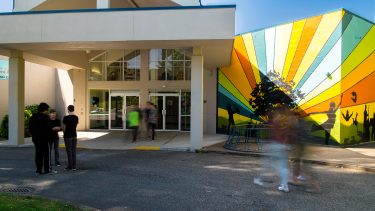
School Name History
Location
36232 Lower Sumas Mountain Road, Abbotsford, BC
Opened
2006
The School
Originally, the ASIA school building was Abbotsford Traditional Secondary. It opened in 2004 in the former Mountain Park Community Church on Lower Sumas Mountain Road. The purchase agreement permitted the church to continue holding some activities and Sunday services in the school building. The renovated building included two science labs, a gym, ten classrooms, an art room, a music room, a student lounge, and an industrial kitchen. There was a wireless computer system throughout the building and every student was given a laptop. As the school principal said, “Every classroom is a computer lab.”
Two years later, the school district decided to reorganize the choice programs of the district. Simpson Traditional Middle School would join Abbotsford Traditional Secondary in one campus. In 2006, the traditional middle and secondary students moved to their new campus on Windsor Street. That same year, the Fine Arts programs from North Poplar (Grades 6-8) and Abbotsford Senior Secondary were moved to the former home of Abbotsford Traditional Secondary on Lower Sumas Mountain Road. This new combined school was named Abbotsford School of Integrated Arts (ASIA). The school’s capacity was one thousand fifty students, but at first, only Grades 6-9 students were registered. The plan was to add a grade every following year until Grades 6-12 were included. The move was intended to relieve overcrowding at North Poplar and reduce the waiting lists for the fine arts program by expanding the capacity.
Origin of the Name
The school was named for the community of Abbotsford. Abbotsford was named by an early settler, John Charles Maclure. In 1888, Maclure sold the right of way through his land to the Canadian Pacific Railway. He sold the right of way on condition that they build a train station there. He named this place Abbottsford in honour of a family friend Henry “Harry” Abbott. Abbott was the western superintendent of the CPR. Originally, on many maps and documents, the name was spelled with two “t”s. In 1922, there was a petition to change the spelling to “Abbotsford,” like the name of the home of a famous Scottish writer, Sir Walter Scott. In a letter from 1924, Maclure said the town was named after Harry Abbott, but still the modern spelling with one ’t' links the town’s name to Sir Walter Scott’s home. In 1813, Scott named his home after a nearby river crossing or ford. The crossing was called Abbotsford because the monks of an abbey used the ford to cross the River Tweed. An abbey is a religious community whose leader is called an abbot.
The Early Community
For thousands of years, the Sto:lo, the People of the River, lived here in the Fraser Valley. In the 1800s, the Sto:lo were displaced as people from Britain, Europe, and other countries arrived. The gold rush of 1858 brought the first wave of people from all over the world. By the 1860s, new settlers began establishing farms on the Sumas and Matsqui Prairies. The coming of the Canadian Pacific Railway in 1887 brought another wave of settlers. The dense forests disappeared as they were cleared for farmland and lumber mills sprang up. The village of Abbotsford was established in 1891. It grew over the years to a town. In 1955, it became the city of Abbotsford when it joined with the municipalities of Sumas and Matsqui.
The Abbotsford School District graciously acknowledges the Abbotsford Retired Teachers Association for collecting the histories and stories of our schools as part of their "What's in a name?" 50th-anniversary project.